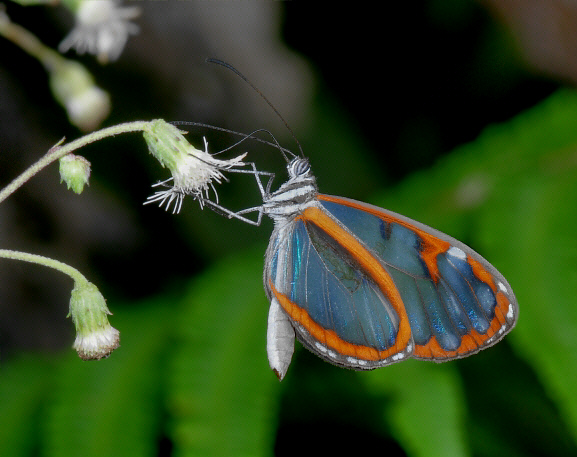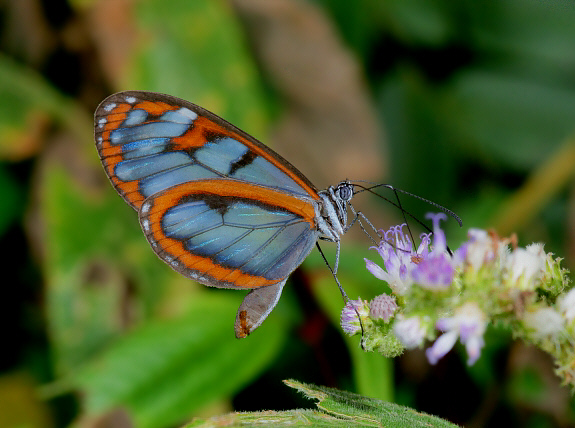
Introduction
The Ithomiini comprises of 376 known species, although it is likely that at least another 30 will be discovered in the near future. All are confined to the neotropical region. Ithomiines are unpalatable to birds, and are consequently mimicked in appearance by many other species. These include other unpalatable species ( Müllerian mimics ), not only from the Ithomiinae but also from several other butterfly families. There are also a large number of edible species ( Batesian mimics ) which have evolved similar patterns. Birds have the ability to memorise butterfly patterns and so learn to avoid eating noxious species, but are also fooled into ignoring similarly marked edible species.
Ithomiines are characterised by having small eyes, slender abdomens and long drooping antennae that lack distinct clubs. Males have a plume of long androconial scales or “hair pencils” on the costa of their hindwings. These are hidden from view when the butterflies are at rest, but are displayed when the wings are held open during courtship. Other Ithomiine characteristics include a very slow and deep wing beat, and a preference for inhabiting the darkest recesses of the forest understorey.
There are basically 2 types of Ithomiine. The first type are the black and orange-banded “tigers”, many of which are mimicked by other species due to their unpalatability to birds. The second type are the “glasswings”, recognised by their transparent or translucent wings, prominent veins, and orange wing margins. Many genera contain examples of both of these types, and in some cases an individual species may produce adults of both forms according to location.
The genus Oleria comprises of about 50 known species, characterised by the distinctive venation of the hindwings. Oleria padilla is a common and widespread species found from Ecuador to Bolivia. There are 6 known subspecies, including the illustrated pseudomakrena which occurs in the Andes of southern Peru and Bolivia.

Habitats
This subspecies occurs at altitudes between about 1200-1800m on the eastern slopes of the Andes.
Lifecycle
I have no data specific to padilla but the following generalisations can be regarded as applicable to the genus Oleria : The eggs are white. They are laid singly although several may be dotted about on one plant by any particular female. The larvae are dull greyish-green, with a wrinkled texture, and have small shiny black heads. They feed on Solanum or Lycianthes ( Solanaceae ). The pupae are usually pale green, unmarked, and have compressed abdominal segments and a dorsal hump.
Adult behaviour
Like other Ithomiines, the butterflies spend long periods at rest on the foliage of small shrubs in the darkness of their rainforest and cloudforest habitats. They are extremely nervous, and if disturbed fly immediately, only to resettle on another nearby leaf. The flight is very slow, with characteristic deep wing beats. When feeding in the open they behave very differently – both sexes being very placid and reluctant to leave their flowers.
Males sequester pyrrolizidine alkaloids from Heliotropium, Tournefourtia, Myosotis ( Boraginaceae ), Eupatorium, Neomiranda and Senecio ( Asteraceae ). These chemicals confer toxic qualities to the butterflies which deter bird attacks. The chemicals are also used in the production of pheromones. Often the males of several Ithomiine species will gather together at communal leks, where they release these pheromones from hair-like androconial scales on the leading edge of their upperside hindwings. These attract more males, which in turn release further pheromones. After a few days the lek may include 50 or more adults comprised of as many as dozen different species. Passing females are attracted to the leks by the complex fragrances. Their presence stimulates the males to open their wings and release further pheromones that entice them into copulation. Females obtain sustenance from nectar, and also visit bird droppings which provide them with a source of nitrogen that assists with the development of their eggs.
In common with most other Ithomiines, lateral and altitudinal migrations of Oleria species are triggered by seasonal changes in humidity.
